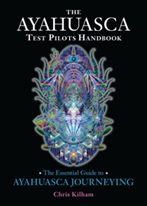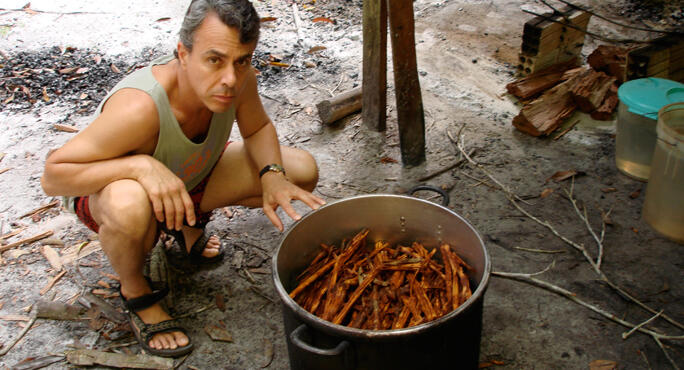Common Name
Botanical Name
AKA
True healing puts into order the body, mind and spirit with the past, present and future. What kind of agent or method or formula or treatment can help to effect such sweeping, integrated healing? I offer for your consideration ayahuasca, a psychoactive potion indigenous to the Amazon rainforest, and the only combinatory vision-inducing agent in the world. Made from the vine Banisteriopsis caapi (often called caapi) and the leaf Psychotria viridis, (known as chakruna) ayahuasca is both a portal to the spirit world, and an enigma that has baffled scientists and anthropologists for centuries.
Ayahuasca, traditionally administered in special healing ceremonies by highly trained shamans known as ayahuasceros, is sometimes referred to as a hallucinogen. But it is no such thing. For while a hallucinogen produces visual phenomena rooted in the individual psyche, ayahuasca opens up channels to the spirit world, and the drinker/participant bears witness to that landscape. Best to name ayahuasca a sacred plant medicine. For among those with whom the ceremonial healing use of ayahuasca is a way of life, the brew is referred to as “La Medicina,” the medicine.
In nature a number of plants and fungi are known for their vision-inducing effects. Peyote, San Pedro cactus, Iboga and the Psilocybe mushrooms are all used in traditional ceremonies to gain access to the spirit world, and to effect healing. But unlike all of these single-species agents, ayahuasca is combinatory- made up of two plants- and there the mystery is greatly compounded.
In the Amazon rainforest, approximately 80,000 higher plants grow in that lush, verdant environment. Perhaps as many as 10,000 plants are vines. Virtually all of the plants in the Amazon have leaves. And yet, somehow, somebody figured out to use one particular species of vine (Banisteriopsis caapi), and one species of leaf (Psychotria viridis), to make a ceremonial psychoactive brew. Here the so-called trial-and-error theory dissolves like sugar in water. Neither the vine nor the leaf is especially distinguished in appearance. There is simply nothing morphological to suggest that either one, or the two together, would in any way be more suitable for the making of a psychoactive healing brew than any other plants. The odds of selecting these two plants from all the others is a multi-billion to one long shot. So how did this take place? The shamans will soberly tell you that the plants originally told people.
 The Ayahuasca Test Pilots Handbook
The Ayahuasca Test Pilots Handbook
“People testing ayahuasca will gain much from reading this book before take-off. Chris Kilham knows his plants, his writing is fun, and the book itself is packed with knowledge.” —Jeremy Narby, author of The Cosmic Serpent
The vine Banisteriopsis caapi, also known as “the vine of the soul,” contains a group of compounds called harmala alkaloids. These compounds are MAO inhibitors. They prevent the activity of naturally-occurring agents in our bodies called monoamine oxidase. Think of MAO’s as doormen standing in front of the night club of your brain. Psychoactive compounds, notably the potent vision-inducing agent DMT, want to get into the club and attach themselves to your brain’s receptors. But the MAO doormen prevent this from happening. The harmala alkaloids in Banisteriopsis caapi, however, tell the doormen to take a nice log coffee break. They do. That’s when the Psychotria viridis, rich in DMT (N,N Dimethyl Tryptamine), comes into play. DMT is the most potent vision-inducing agent known. And oddly, DMT is not only found in many hundreds of plants all around the world, but it is also manufactured in our own bodies. But thanks to MAO’s, we do not trip on DMT all day long.
DMT is not orally active. You can eat a handful of DMT, and nothing will happen. But if you consume an MAO inhibitor, then the DMT will in fact be orally active. So the enigma of ayahuasca is that somehow, by some means, some native person(s) a long time ago figured out to combine harmala alkaloid-rich caapi vine with DMT-rich chakruna.
Ayahuasca is made by pounding sections of the vine Banisteriopsis caapi, to remove the outer bark, and to soften up the rope-like fibers of the vine. A large amount of pounded caapi vine is placed into a large cooking pot. Atop the pounded vine, a large quantity of Psychotria viridis (chakruna) leaves are added. Then another layer of pounded vine is added, then another layer of leaves. When the pot is pretty filled almost to the top with pounded vine and leaves, then water is added. If the pot is large enough, as much as forty litres of water may be added. Then the mixture is cooked over a fire for several hours. Over time, the liquid in the pot begins to evaporate. After several hours, perhaps eight or so, the ayahuasca is finished. The pieces of vine and leaves are filtered out through a strainer. Perhaps only a litre of viscous fluid remains. This liquid is “La Medicina.”
While ayahuasca ceremonies vary from one shaman to another and from one tribal tradition to the next, certain features remain constant. A true ayahuasca ceremony brings together the ayahuasca brew, the shaman(s), and the plant spirits. This triune force engages in ceremony to effect healing, and to open up the doors of the spirit world to the participant. Typically an ounce or two of the brew is drunk. The ayahuasca brew is intensely bitter, and the taste is unpleasant, even for those who are experienced drinkers.
In some ceremonies, the shaman(s) sit quietly with the participants in the dark for about forty-five minutes or so, as the effects of the ayahuasca start to come on. However, some shamans begin to sing and make ethereal whistling sounds as soon as the brew has been drunk. Some shamans wave chacapas - noisy leaf fans – and others do not. It is typical and common for the shaman to blow smoke of potent Amazonian tobacco (called mapacho) on participants, to cleanse the atmosphere and to establish an aura of protection.
Within about an hour after drinking the brew, visions usually commence. There is a geometry common to the ayahuasca experience, and this geometry is beautifully represented in the textiles and ceramics of the Shipibo native people of Peru. Most people who journey with ayahuasca see that geometry. As the visions increase, the shaman(s) sing healing spirit songs known as icaros. These evocative, haunting tunes bring the yravlere deeper into the ayahuasca mystery.
If you ask the ayahuasca for healing, it will usually provide what you seek. There are many thousands of cases in which people have been healed of physical, mental and emotional disorders, and many curious cases of recovery from grave and even fatal disorders. There is much to investigate about the healing properties of ayahuasca. A large number of people have been cured of addictions through a few ayahuasca ceremonies, and the cases of post-ayahuasca cancer remission are too numerous to ignore.
Purging is typical and common in the ayahuasca ceremony. Most participants throw up at some point in ceremony. Some also get diarrhea. The cleansing effects of ayahuasca are well known, and are just part of the ceremony. For most participants, purging is a relief. Typically the purging does not last long, and the ayahuasca experience becomes stronger afterward.
People see and experience all kinds of phenomena while on an ayahuasca journey. You may see deceased relatives, spirits of every kind, vast landscapes of natural or manufactured forms, animals, insects, serpents, birds, and various creatures of nature. And as you engage in ceremonies over time, you start to learn to negotiate the spirit landscape, and to enlist the aid of certain spirits for your own healing and spiritual awakening.
For the person who has never participated in an ayahuasca ceremony, it is easy to assume that the brew causes the drinker to hallucinate, and that this explains the ayahuasca experience. But when you have engaged in ayahuasca ceremonies with highly trained shamans who make the brew correctly, such simplistic and reductionistic explanations fall apart completely. The spirit landscape, in all its mystery, beauty, splendor, terror, majesty and strangeness, is its own world, and the ayahuasca lets you into that world.
Ayahuasca is clearly not for everybody. The experience is typically intense, and can be terrifying. The spirit landscape is beautiful, but can also be overwhelming. Still, ayahuasca helps to put into order the body, mind and spirit with the past, present and future. Because of this extraordinary healing power, ayahuasca is a revered brew, and ayahuasca ceremonies are increasingly sought after by people from all over the world. Some flock to Peru, Brazil, Colombia and Ecuador to participate in ceremonines in the Amazon, and others drink in urban and suburban venues, in ceremonies led by shamans who tour. In many ways, through a great many people, ayahuasca, La Medicina, is making itself known. This potent Amazon brew has the power not only to heal, but to transform your understanding and experience of reality.

The All-Star Shaman, All Night Ayahuasca Massacree
When we first assembled in the maloca for the night’s ayahuasca ceremony, an apocalyptic rain howled out of the jungle, pounding the palm-leaf roof of the building hard, rendering conversation impossible. The rain fell in sheets of bullets, hard and fast, almost shocking in its intensity. Dogs in surrounding villages went completely nuts, howling and barking. The downpour lasted for over an hour, full metal jacket...
“Not every ayahuasca ceremony offers a breezy ride. But the medicine always does offer insight and healing, if you can stay aware and navigate the strong currents in the ceremonial space.” – Chris Kilham, AlterNet
Photo: Chris Kilham by Russ Quackenbush


